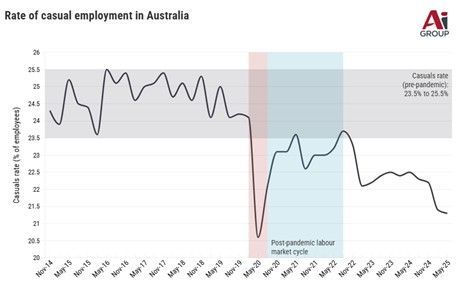Despite market uncertainty, Australian businesses are employing less casuals. An Australian Industry Group (AiG) Fact Sheet shows the rate of casual employment is 21.3%, significantly below the long-term range of 23.5% to 25.5%.
This is due to several factors, including the Closing Loopholes (No.2) Act 2024, which redefined casual employment. With the Fair Work Commission now looking to review part-time provisions, we examine available options for employers.
Key points:
- The statistics show a steady decline in casual employment post-pandemic, most notably since May 24.
- Casual employment for professionals is valuable because it provides essential support to permanent teams during peak periods, helping to manage workloads effectively while also creating pathways for emerging talent to build their experience.
- Many professionals are keen to take on contingent work to improve skills and re-enter the workforce. For employers this presents an excellent opportunity to access highly skilled and experienced professionals who can deliver immediate value and support business needs.
- We examine the purpose and conditions of three options to engage contingent workers that comply with legislation.
A recent AiG Fact Sheet to May 2025 acknowledges that casual employment is most common in five industries: accommodation and food, retail trade, arts and recreation, administrative and support and agriculture. While industrial sectors like construction, manufacturing, mining, wholesale trade and utilities have below-average rates of casualisation. The Fact Sheet doesn’t break down which areas are most impacted, yet it provides a clear picture of a steady decline (see the rate of casual employment in Australia graph below).
“We have seen this decline in casual employment play out across three of our five recruitment specialisations, affecting engineering, scientific and technical professionals,” says Wayne Eaton, General Manager. “Education has been the least impacted, particularly from a teaching standpoint.”
There are several key factors to this decline, including reduced business confidence and the Closing Loopholes (No.2) Act 2024, which changed the definition of casuals. Interestingly, the first is often a key reason an organisation may choose to engage casuals over permanent employees. The second factor is a risk aversion tactic, which has been employed because organisations are nervous about complying with the complex legislation.
The Fair Work Commission has recently initiated a new case that will include a review of part-time provisions in certain Modern Awards (AM2025/17). It is looking into several changes to part-time employees, with some of the proposed changes including:
- How agreed hours of employment are established and how an agreement to change them would apply
- Minimum or maximum hours per day and/or weekly
- Additional hours and when overtime will apply
Depending on the changes, this may impact on the attractiveness of casual work. However, for those organisations replacing contingent workers with part-time employees, further restrictions, additional costs, and monitoring requirements may become a reality in the future. It is therefore important to understand why casual employment matters, how candidates feel about it, and how you can compliantly engage professionals.
Why does a reduction in casual employment matter?
In many instances, it doesn’t! The intention of changing the definition of casuals was to improve employment stability for Australians, and for many this has been successful.
However, in a volatile market there are unintended consequences when organisations are reluctant to engage contingent staff. Below is just a few.
- Understaffing – this can occur due to uncertainty or company mandated headcounts, placing additional pressures on project delivery and therefore employees.
- Less jobs – without the option to hire contingent professionals, many organisations decide to ‘make do’ with the resources they have, rather than employing additional staff
- Employment pathways – contingent employment is often a pathway to a permanent job, as professionals have time to make themselves invaluable to the organisation
- Traditional contractors – whether this be communications professionals, engineers, designers or others, many professionals opt for contract work to have more control over how and when they work, and to increase their pay rate for the actual hours they do work.
As such, a reduction in casual professionals can decrease morale and capability over time, while seeing professionals with a high level of expertise exit the employment market. As these professionals are not necessarily claiming benefits, this group does not appear in unemployment figures. These factors therefore have significant implications for employers and the future capability of the Australian workforce.
How do professional candidates feel about contingent work?
This will obviously differ based on the individual, their skill set and the market. However, right now many candidates are interested in longer term contingent opportunities.
“There are so many factors shifting in the market at the moment, resulting in more and more professionals finding themselves out of work,” says Wayne. “When talking to candidates, many are keen to take on a casual assignment or maximum-term contracts, which differs significantly to attitudes a year ago.” These contracts may range from 3 months to 2 years.
For candidates, contingent work provides flexibility, exposure to diverse projects, and an opportunity to expand their skills while maintaining career momentum. Many professionals take these roles to broaden their experience, strengthen their networks, and potentially gain access to organisations that may later offer permanent career paths.
For employers, this shift provides an excellent opportunity to secure high-calibre talent for project-based work or to meet short-term business needs, often bringing in expertise that may otherwise be hard to attract in a permanent capacity.
What are the options for engaging contingent professionals?
There are various options for casual employment, and it’s essential to understand the respective purpose, benefits and obligations of each on-hired employment option.
Casual Employees
When your business requires flexibility and temporary staffing solutions, casual employees offer both agility and cost-effectiveness. While notice periods may be as little as one hour depending on the circumstances and contractual requirements, 24 hours is recommended. These employees receive a 25% casual loading and understanding all elements of the relevant Award is critical when managing casual workers, especially what conditions deem them a permanent rather than casual employee. Casuals can be engaged directly by your organisation, or through a Labour Hire company on an on-hired arrangement. Please note the Labour Hire company must have a licence to operate in specific states.
On-hired Ongoing Permanent Employees (OPE)
This is an option for roles requiring consistency, reliability, and long-term investment in team members. On-hired OPE’s provide stability and potential for growth, without the headcount. Employees are entitled to appropriate notice periods and payouts for accrued annual leave and long service leave, with notice periods typically 1 – 5 weeks. Redundancy payments are determined by the length of continuous service and are aligned with the Fair Work Act, like permanent employment. Please note, not all labour hire/recruitment companies provide this option.
Maximum Term Employees (MTE)
This is a great option when you have a defined project timeline or need to cover a prolonged absence, as Maximum Term employees offer a structured and flexible staffing solution. An employee can be employed on a maximum-term basis for up to two successive contracts, or for a maximum period of two years. After this period, they must be converted to an OPE if continuing the same assignment. This model is like an OPE arrangement in terms of notice periods and entitlements, it simply has a pre-determined termination date.
Once you’ve determined the engagement model to best meet your business needs, you will need to:
- Ensure contracts are drafted correctly to match requirements in the legislation
- Review organisational policies to include any specific requirements or exclusions for these employees
- Put systems in place to monitor employment durations, payments and Award conditions for compliance.
Bayside Group, in conjunction with our Workplace Relations team, has the expertise and systems in place to supply contingent professionals, whether you require a single specialist or a complete project team. We can navigate complex legislative requirements on your behalf, taking on the employment responsibility so you can focus on your core business. Learn more.




